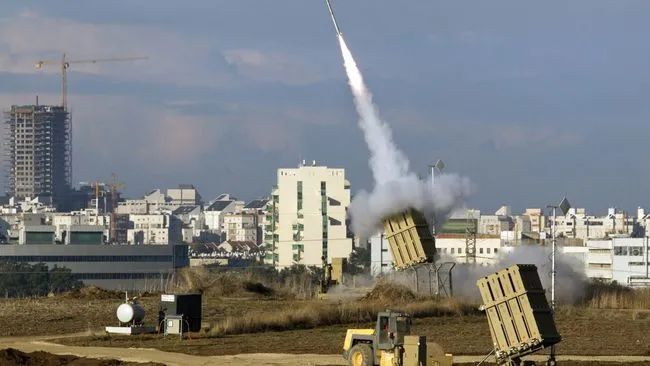The recent increasing israeli-Palestinian conflict has left images of rockets clearing the night sky on the Internet, while Israel’s “Iron Dome”, which intercepts thousands of rockets fired by Hamas, has left military fans exclaiming. Today, Lao Liu and everyone said, “Iron Dome” this anti-aircraft weapon performance, Israel’s development of this system to China what inspiration? Should China develop an “Iron Dome” air defense system?
Let’s first look at recent news reports that since the evening of the 10th of this month, Palestinian forces have fired a large number of rockets into Israeli territory. Videos and photos of Israeli “Iron Dome” intercepting rockets have also appeared on social media. It is understood that the “Iron Dome” is a unique National Conditions of Israel’s anti-aircraft weapons. At the beginning of its design, it was developed as an anti-rocket, artillery and mortar system (C-RAM), which was improved, the radar was replaced to upgrade combat procedures, and the maneuverable I-Dome and the ship-borne C-Dome ultra-short-range air defense system were derived to deal with aerodynamic targets such as cruise missiles.
According to Russian satellite news network reported on the 13th, the Israeli military said in a recent statement, (militants) from the Gaza Strip to Israeli territory fired nearly 1,500 rockets, of which about 350 failed to launch, rockets fell into the Gaza Strip. The Iron Dome air defense system intercepted hundreds of rockets. Israeli officials say the system has a 90 percent success rate, but it does not intercept all rocket attacks and only intercepts them if they are judged to pose a threat to densely populated areas or important facilities. Experts believe that the main advantage of the “Iron Dome” is a relatively low cost, intercepting a certain size of rockets, howitzers and mortar shells. Other countries are also equipped with C-RAM systems, but mainly short-range machine guns. For example, the U.S. Army equipped with “intensive array” system. Mainly used to protect overseas bases from sporadic artillery fire. Israeli cities face larger, larger rocket attacks and larger areas to protect, forcing the development of a new missile-based interceptor system.

After communicating with a military expert familiar with air defense, Lao Liu combed out the following points:
First, in general, intercepting rockets and mortar shells is not very difficult. It doesn’t fly as fast as ballistic missiles, it doesn’t fly as fast as aircraft, it doesn’t fly as low as cruise missiles. In addition, the Palestinian armed forces will not carry out electromagnetic interference on the Israeli side. What the Iron Dome needs to do is to be resilient to saturation and to keep costs as low as possible. To this end, it uses the active RF pilot and anti-missile system will use the reverse ballistic intercept technology, enhance the multi-target strike capability and hit rate.
Second, the “Iron Dome” price-performance ratio is not as low as netizens question. Although the “Iron Dome” interceptor rocket is considered too cheap, but with The old Liu exchange experts believe that its interceptor bomb price is not high. There are currently $20,000, $40,000, $100,000, $200,000. Even $200,000 is cheap for an air defense weapon of about the size. Take the U.S. Ram anti-aircraft missile, for example, which currently has about $800,000. The purchase price of the U.S. AIM-9X air-to-air missile has also been around $500,000 in recent years. While the Iron Dome interceptor is expensive relative to Palestinian-armed rockets, the money should be well worth the cost of the loss of life and economic losses caused by these rockets, the panic caused by the Israeli population and the resulting chaos.
Third, the use of “iron dome” for interception, is the ultimate defense. In combat, it must still be used in combination with offensive means.
Since the Iron Dome is an air defense system with Israeli characteristics that meets their very special security needs, should China develop the Iron Dome missile?
In an exchange with Lao Liu, a military expert, speaking on condition of anonymity, said China’s overall demand for such missiles was low, but not entirely absent from such scenarios. For example, armed conflicts occur in neighbouring countries in our border areas, and if occasional shells fall into our territory, then the system can work (as has not happened before). In addition, China’s overseas security bases or peacekeeping force camps may also be subject to indiscriminate sporadic artillery fire if the host country is caught in the fighting.
Does China have its own “Iron Dome” defense system? The answer should be yes, China’s military industry after these years of rapid development, forming a relatively perfect model genealogy. Some analysts believe that there are two ways to deal with the above-mentioned Chinese possible application scenarios. One way is to perform similar tasks with a slight improvement to existing equipment. For example, the “Land Shield” near-defense system, it is similar to the United States “dense array” system, performance will be better, slightly improved can be used to carry out rockets, artillery defense tasks. Of course, this artillery coverage is relatively small, more suitable for small bases, camps protection, to deal with sporadic attacks.
The second way is to use the radar of the existing air defense system, with the existing short-range anti-aircraft missile improvement model, improve the development of a similar “Iron Dome” model, to cope with a larger range, larger-scale rocket attacks, in case of need. This allows you to “do more with less”. For example, using advanced radars of the Red Flag-9 air defense system, or larger phased array gun position detection radars, its operational procedures have been redeveloped to guide improved interceptors based on the missiles of the Red Flag-17 air defence system. The main reason for the “Red Flag-9” such a large-scale radar system is to be able to detect artillery shells, rockets and other small targets at long distances. Small interceptors are used to reduce the cost of intercepting them.
However, in the face of saturated rocket attacks, high-intensity intercept operations have even failed an “Iron Dome” system, unable to intercept incoming rockets, resulting in multiple casualties. Therefore, if we want to achieve a more ideal anti-saturation attack capability, but also for interceptors equipped with active radar guide to improve multi-target combat capability. This kind of active radar guide head is not technically difficult to develop, mainly how to reduce the cost. In addition, the reliability and continuous working hours of the system are enhanced, enabling the entire system to be on duty for long periods of time and to respond to random attacks without warning and sustained attacks over time.



